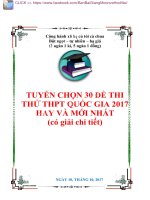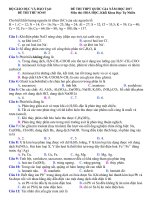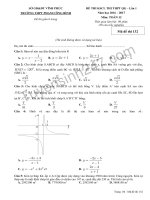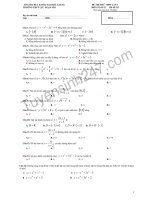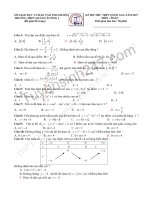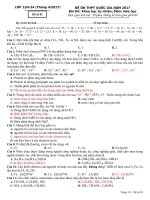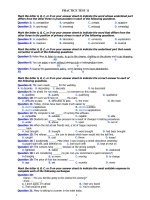- Trang chủ >>
- Đại cương >>
- Kinh tế vĩ mô
DE THI THU THPTQG 2017
Bạn đang xem bản rút gọn của tài liệu. Xem và tải ngay bản đầy đủ của tài liệu tại đây (233.54 KB, 11 trang )
<span class='text_page_counter'>(1)</span>ĐỀ THI THỬ SỐ 14 - THPTQG 2017 Thời gian: 60 phút. Mark the letter A, B, C or D on your answer sheet to indicate the word that differs from the other three in the position of primary stress in each of the following questions. Câu 1: Câu 2:. A. considerate A. apply. B. photographer B. anthem. C. community C. appear. D. circumstance D. attend. Mark the letter A, B, C or D on your answer sheet to indicate the word whose underlined part differs from the other three in pronunciation in each of the following questions. Câu 3: Câu 4:. A. meat A. laid. B. team B. fair. C. sea C. repair. D. clear D. pair. Mark the letter A, B, C or D on your answer sheet to indicate the underlined part that needs correction in each of the following questions. Câu 5: Educated in the UK (A), his qualifications are (B) widely recognized (C) in the world of professionals. (D) Câu 6: Many successful (A) film directions (B) are former (C) actors who desire to expand (D) their experience in the film industry. Câu 7: We admire Lucy for (A) her intelligence (B), cheerful disposition (C) and she is honest. (D) Mark the letter A, B, C or D on your answer sheet to indicate the correct answer to each of the following questions. Câu 8: If she sick, she would have gone out with me to the party. A. hasn’t been B. wasn’t C. weren’t D. hadn’t been Câu 9: Prizes are awarded the number of points scored. A. according to B. because of C. adding up D. resulting in Câu 10: While southern California is densely populated, live in the northern part of the state. A. a number people B. many people C. few people D. a few of people Câu 11: The building has a smoke detector any fires can be detected immediately. A. so that B. if C. such as D. as if Câu 12: It was announced that neither the passengers nor the driver in the crash. A. were injured B. are injured C. was injured D. have been injured Câu 13: The two countries have reached an agreement through dialogues described as . A. counterproductive B. unproductive C. productivity D. productive Câu 14: Anne persisted her search for the truth about what had happened. A. at B. about C. in D. on Câu 15: Ensure there is at least a 3cm space allow adequate ventilation. A. so as to B. so that C. in view of D. with a view to Câu 16: Why don’t you ask the man where to stay? A. he would rather B. he feels like C. would he like D. he would like Câu 17: My car is getting unreliable; I think I'll trade it for a new one. A. off B. away C. in D. up Câu 18: The old houses were down to make way for a block of flats. A. banged B. hit C. knocked D. put.
<span class='text_page_counter'>(2)</span> Câu 19: that she burst into tears. A. Her anger was such B. So angry she was Câu 20: Anne: “Thanks for the nice gift!” John: “ ” A. In fact, I myself don’t like it. C. I’m glad you like it. Câu 21: “Would you like something to eat?” – “ .I’m not hungry now” A. Yes, I would B. No, no problem. C. She was so anger. D. Such her anger was. B. You’re welcomed. D. But do you know how much it costs? C. No, thanks. D. Yes, it is. Mark the letter A, B, C, or D to indicate the phrase that is CLOSEST in meaning to the underlined ones. Câu 22: She had no qualms about lying to the police A. distress B. impunity C. persevere D. scruple Câu 23: We admired the expertise with which he prepared the meal A. activity B. courage C. mastery D. effort Mark the letter A, B, C, or D to indicate the phrase that is OPPOSITE in meaning to the underlined ones. Câu 24: These investments have remained dormant for several years A. clever B. active C. energetic Câu 25: It was not for his friend to abate the confidence A. free. B. augment. C. provoke. D. invisible D. wane. Chọn phương án đúng (A hoặc B, C, D) ứng với câu có nghĩa gần nhất với mỗi câu cho sẵn sau đây. Câu 26: David drove so fast; it was very dangerous. A. David drove so fast, which was very dangerous. B. David drove so fast and was very dangerous. C. David drove so fast, then was very dangerous. D. David drove so fast that was very dangerous. Câu 27: The captain to his men: “Abandon the ship immediately!” A. The captain invited his men to abandon the ship immediately. B. The captain suggested his men abandon the ship immediately. C. The captain ordered his men to abandon the ship immediately. D. The captain requested his men to abandon the ship immediately. Câu 28: The critics undervalued his new book. A. The critics rejected his new book. B. The critics were fed up with his new book. C. The critics had a low opinion of his new book. D. The critics turned down his new book. Câu 29: “Shall I make you a coffee?” the girl said to the lady. A. The girl wanted to make a coffee for the lady. B. The girl offered to make a coffee for the lady. C. The girl refused to make a coffee for the lady. D. The girl promised to make a coffee for the lady. Câu 30: No sooner had she put the telephone down than her boss rang back. A. As soon as her boss rang back, she put down the telephone. B. Scarcely had she put the telephone down when her boss rang back. C. Hardly she had hung up, she rang her boss immediately. D. She had hardly put the telephone down without her boss rang back. Read the following passage and mark the letter A, B, C or D on you answer sheet to indicate the correct word or phrase that best fits each of the numbered blanks from 31 to 35. The wind controls our planet's weather and climate. But how much do we understand about this complex force (31) can kill and spread fear? On the night of October 15, 1987, the south of England was struck by strong winds. Gusts of over 130 km/h (32) through the region. Nineteen people were killed, £1.5-billion worth of damage was (33) and 19 million trees were blown down in just a few hours. Although people thought of this as a hurricane, the winds of 1987 were only a (34) 7 storm. They remain far better known than the much more serious storms of January 25, 1990, when most of Britain was hit by daytime winds of.
<span class='text_page_counter'>(3)</span> up to 173 km/h. On this occasion, 47 people were killed, even though, (35) accurate warnings. Câu 31: Câu 32: Câu 33: Câu 34: Câu 35:. A. what A. ran A. paid A. strength A. when. B. which B. blew B. created B. length B. like. C. when C. flew C. resulted C. power C. unlike. in 1987, the weather forecasters issued D. where D. spread D. caused D. force D. such as. Read the following passage on transport, and mark the letter A, B, C, or D on your answer sheet to indicate the correct answer to each of the questions from 36 to 42. Millions of people are using cellphones today. In many places, it is actually considered unusual not to use one. In many countries, cellphones are very popular with young people. They find that the phones are more than a means of communication - having a mobile phone shows that they are cool and connected. The explosion in mobile phone use around the world has made some health professionals worried. Some doctors are concerned that in the future many people may suffer health problems from the use of mobile phones. In England, there has been a serious debate about this issue. Mobile phone companies are worried about the negative publicity of such ideas. They say that there is no proof that mobile phones are bad for your health. On the other hand, medical studies have shown changes in the brain cells of some people who use mobile phones. Signs of change in the tissues of the brain and head can be detected with modern scanning equipment. In one case, a traveling salesman had to retire at young age because of serious memory loss. He couldn't remember even simple tasks. He would often forget the name of his own son. This man used to talk on his mobile phone for about six hours a day, every day of his working week, for a couple of years. His family doctor blamed his mobile phone use, but his employer's doctor didn't agree. What is it that makes mobile phones potentially harmful? The answer is radiation. High-tech machines can detect very small amounts of radiation from mobile phones. Mobile phone companies agree that there is some radiation, but they say the amount is too small to worry about. As the discussion about their safety continues, it appears that it's best to use mobile phones less often. Use your regular phone if you want to talk for a long time. Use your mobile phone only when you really need it. Mobile phones can be very useful and convenient, especially in emergencies. In the future, mobile phones may have a warning label that says they are bad for your health. So for now, it's wise not to use your mobile phone too often. Câu 36: According to the passage, cellphones are especially popular with young people because . A. they are indispensable in everyday communications B. they make them look more stylish C. they keep the users alert all the time D. they cannot be replaced by regular phones Câu 37: The changes possibly caused by the cellphones are mainly concerned with . A. the mobility of the mind and the body B. the smallest units of the brain C. the arteries of the brain D. the resident memory Câu 38: The word "means" in the passage most closely means . A. “meanings” B. “expression” C. “method” D. “transmission” Câu 39: Doctors have tentatively concluded that cellphones may . A. damage their users’ emotions B. cause some mental malfunction C. change their users’ temperament D. change their users’ social behaviours Câu 40: The man mentioned in the passage, who used his cellphone too often, . A. suffered serious loss of mental ability B. could no longer think lucidly C. abandoned his family D. had a problem with memory Câu 41: According to the writer, people should . B. only use mobile phones in medical emergencies A. only use mobile phones in urgent cases C. keep off mobile phones regularly D. never use mobile phones in all cases Câu 42: The most suitable title for the passage could be . A. “The Reasons Why Mobile Phones Are Popular” B. “Technological Innovations and Their Price” C. “The Way Mobile Phones Work” D. “Mobile Phones: A Must of Our Time” Read the following passage on transport, and mark the letter A, B, C, or D on your answer sheet to indicate the correct answer to each of the questions from 43 to 50 Traditionally in America, helping the poor was a matter for private charities or local governments. Arriving immigrants depended mainly on predecessors from their homeland to help them start a new life. In the late 19th and early 20th centuries, several European nations instituted public-welfare programs. But such a movement was slow to take hold in the United States because the rapid pace of industrialization and the ready availability of farmland seemed to confirm.
<span class='text_page_counter'>(4)</span> the belief that anyone who was willing to work could find a job. Most of the programs started during the Depression era were temporary relief measures, but one of the programs Social Security - has become an American institution. Paid for by deductions from the paychecks of working people, Social Security ensures that retired persons receive a modest monthly income and also provides unemployment insurance, disability insurance, and other assistance to those who need it. Social Security payments to retired persons can start at age 62, but many wait until age 65, when the payments are slightly higher. Recently, there has been concern that the Social Security fund may not have enough money to fulfill its obligations in the 21st century, when the population of elderly Americans is expected to increase dramatically. Policy makers have proposed various ways to make up the anticipated deficit, but a long-term solution is still being debated. In the years since Roosevelt, other American presidents have established assistance programs. These include Medicaid and Medicare; food stamps, certificates that people can use to purchase food; and public housing which is built at federal expense and made available to persons on low incomes. Needy Americans can also turn to sources other than the government for help. A broad spectrum of private charities and voluntary organizations is available. Volunteerism is on the rise in the United States, especially among retired persons. It is estimated that almost 50 percent of Americans over age 18 do volunteer work, and nearly 75 percent of U.S. households contribute money to charity. Câu 43: New immigrants to the U.S. could seek help from . A. the people who came earlier B. the US government agencies C. only charity organizations D. volunteer organizations Câu 44: It took welfare programs a long time to gain a foothold in the U.S. due to the fast growth of . A. industrialization B. modernization C. urbanization D. population Câu 45: The word “instituted” in the first paragraph mostly means . A. “executed” B. “studied” C. “introduced” D. “enforced” Câu 46: Most of the public assistance programs after the severe economic crisis. A. were introduced into institutions B. did not become institutionalized D. did not work in C. functioned fruitfully in institutions institutions Câu 47: That Social Security payments will be a burden comes from the concern that . A. elderly people ask for more money B. the program discourages working people C. the number of elderly people is growing D. younger people do not want to work Câu 48: Americans on low incomes can seek help from . A. federal government B. government agencies C. state governments D. non-government agencies Câu 49: Public assistance has become more and more popular due to the . A. young people’s voluntarism only B. volunteer organizations C. people’s growing commitment to charity D. innovations in the tax system Câu 50: The passage mainly discusses A. public assistance in America C. funding agencies in America. . B. immigration into America D. ways of fund-raising in America.
<span class='text_page_counter'>(5)</span> KEYS CHI TIẾT. 1. D Trọng âm của từ circumstance rơi vào âm tiết thứ nhất, còn các từ còn lại trọng âm rơi vào âm tiết thứ 2 Considerate: /kən'sidərit/ Photographer: /fə'tɔ grəfə/ Community: /kə'mju:niti/ Circumstance: /'sə:kəmstəns/ 2. B Giải thích: Trọng âm của từ anthem rơi vào âm tiết thứ nhất, còn các từ còn lại trọng âm rơi vào âm tiết thứ 2. Apply: /ə'plai/ Attend: /ə'tend/.
<span class='text_page_counter'>(6)</span> Appear: /ə'piə/ Anthem: /'ænθəm/ 3. D clear đọc là /iə/, các từ còn lại đọc là /i:/ 4. A laid đọc là /ei/, còn lại đọc là /eə/ 5. B Đây là câu rút gọn chủ ngũ khi chủ ngữ ở vế 1 và 2 cùng chủ ngữ. Chủ ngữ trong vế 1 là he (he was educated in the UK), nhưng chủ ngữ ở mệnh đề 2 lại là his qualifications sai. 6. B Giải thích: film directions → film directors (các đạo diễn phim). 7. D Cấu trúc song song: she is honest → her honesty vì trong một chuỗi liệt kê thì các từ (cụm từ) phải cùng thuộc 1 lớp từ loại.Trong câu này her intelligence và cheerful disposition là cụm danh từ thì sau từ nối and cũng phải là 1 cụm danh từ. 8: D Giải thích: Động từ trong mệnh đề chính của câu trên được chia ở dạng tương lai hoàn thành trong quá khứ (would have gone) do đó động từ ở mệnh đề If tương ứng phải ở dạng quá khứ hoàn thành (hadn’t been). Câu trên thuộc mẫu câu điều kiện loại III (không có thật trong quá khứ): If + QKHT (had done), S + would have done. 9: A Giải thích: according to sth (theo như cái gì), because of (bởi vì), adding up (tính tổng, cộng tất cả lại), resulting in (dẫn tới kết quả). “The number of points scored” là điều kiện để xét giải thưởng nên ta phải dùng “according to” . Khi đó câu trên được hiểu là “Các giải thưởng được trao theo số lượng điểm ghi được.” 10: C Giải thích: Câu trên bắt đầu bằng While (trong khi mà), do vậy nó diễn đạt 2 vế mang nghĩa trái ngược nhau. Chúng ta thấy mệnh đề “While southern California is densely populated…(Trong khi ở phía Nam California dân số đông đúc…) mang nghĩa khẳng định nên mệnh đề còn lại phải mang nghĩa phủ định. Do vậy few people (ít có người/ ít người) là đáp án chính xác. a number people, many people đều mang nghĩa có nhiều người, a few of people (một vài người). 11: A Giải thích: so that (nên), if (nếu), such as (như là), as if (như thể). Mệnh đề đứng trước phục vụ cho mục đích được nêu ở mệnh đề sau nên “so that” là đáp án. Khi này câu được hiểu là “Tòa nhà có một bộ máy dò khói nên bất kỳ ngọn lửa nào cũng bị dập tắt ngay tức khắc.” 12: C Giải thích: động từ trần thuật trong câu được chia ở thì quá khứ đơn giản “was announced” do vậy các đáp án are injured (động từ chia ở thể bị động thời hiện tại đơn giản), và have been injured (động từ chia ở bị động.
<span class='text_page_counter'>(7)</span> thời hiện tại hoàn thành) không phải là sự lựa chọn chính xác. Chủ ngữ đứng gần động từ cần được chia nhất ở dạng ngôi thứ ba số ít vì thế đáp án đúng là was injured. 13: D Giải thích: counterproductive (mang tính hiệu quả trái với mong muốn), unproductive (không mang tính hữu ích), productivity (năng suất), productive (hữu ích). Xét về mặt ý nghĩa thì đáp án productive là phù hợp hơn cả. Khi đó câu được hiểu là “Hai quốc gia này đã tiến tới một hợp hiệp định thông qua các cuộc đàm phán được coi là mang tính hữu ích.” 14: C Giải thích: ta có cấu trúc to persit in sth/ Ving mang nghĩa khăng khăng làm điều gì. 15: A Giải thích: so as to (để/ để mà), so that (nên), in view of (xét thấy, bởi vì), with a view to (với ý định/ với hy vọng). Về mặt ý nghĩa của câu thì so as to là phù hợp hơn cả. Khi này câu được hiểu là “Đảm bảo có ít nhất một khoảng trống 3cm để cho vừa đủ lỗ thông gió.” 16: D Giải thích: chúng ta có cấu trúc would like to do sth mang nghĩa thích làm điều gì đó. 17: C Giải thích: cụm từ to trade sth in mang nghĩa đổi cái cũ lấy cái mới (có các thêm tiền). 18: C Giải thích: cụm từ to knock down mang nghĩa phá đổ (nhà), dỡ (nhà). 19: A Giải thích: such that mang nghĩa đến nỗi mà/ đến mức mà là đáp án chính xác. Khi này câu được hiểu là “Nỗi tức giận đến mức làm cô ấy òa khóc.” 20. C Cảm ơn vì món quà thật tuyệt/ mình rất vui khi bạn thích nó 21. C Bạn có muốn ăn gì không/Không, cảm ơn nha, giờ mình chưa đói 22. D scruple = qualm: sự do dự, ngại ngần distress: sự phiền muộn impunity: sự miễn tội perservere: sự kiên trì 23. C expertise = mastery: thông thạo việc gì.
<span class='text_page_counter'>(8)</span> activity: hoạt động courage: sự can đảm effort: sự cố gắng 24. B dormant ≠ active: im lìm, không hoạt động ≠ hoạt động tích cự clever: thông minh energetic: mạnh mẽ, tràn đầy năng lượng invisible: vô hình 25. B abate: làm dịu đi ≠ augment: làm tăng lên 26. A Giải thích: It trong “it was very dangerous” thay thế cho cả mệnh đề “David drove so fast”. Viết lại câu đã cho bằng cách dùng mệnh đề quan hệ với which – which có thể thay thế cho mệnh đề đứng trước. 27: C Giải thích: Câu nói trực tiếp là câu mệnh lệnh và có thái độ ra lệnh (động từ abandon và dấu chấm cảm cuối câu). Tương ứng với nó ở dạng gián tiếp ta dùng order sb + to infinitive (ra lệnh cho ai đó làm gì). 28: C Giải thích: to undervalue = to have a low opinion: đánh giá thấp, coi rẻ, coi thường. Câu C là cách viết lại của câu đã cho bằng cách dùng cụm từ tương đương. 29: B Giải thích: “Shall I make you a coffee?” là một câu mời lịch sự do đó khi chuyển sang gián tiếp ta dùng động từ offer (đề nghị, đưa ra mời). 30: B Giải thích: No sooner…than: ngay sau khi…thì. Câu đã cho có nghĩa như sau: “Ngay sau khi cô ấy đặt điện thoại xuống thì sếp của cô ấy gọi lại”. Các câu C, D đều sai về mặt ngữ pháp. Câu C phải đảo động từ lên trước chủ ngữ vì có trạng từ đứng đầu câu. Câu D sai vì sau without không là mệnh đề mà phải là danh từ hoặc Ving. Câu A sai về mặt ngữ nghĩa: “Ngay khi sếp cô ấy gọi lại, cô ấy đặt luôn điện thoại xuống” Đáp án đúng là B. Để tham khảo phương pháp làm bài tập dạng này mời bạn tham khảo tại đây. 31: B Giải thích: Chỗ trống cần điền là một đại từ quan hệ bổ sung ý nghĩa cho cụm từ “this complex force” nên đại từ chỉ vật “which” là phương án thích hợp nhất. Lưu ý ta không thể dùng “what” vì mệnh đề quan hệ không có hàm ý nghi vấn, dấu chấm hỏi là của cụm từ “how much” ở đầu câu. 32: B Giải thích: Run: chạy (người và động vật); blow: thổi, cuốn đi (gió); flow: chảy (nước); spread: trải, căng ra, bày ra. “130 km/h” trong đoạn văn là con số chỉ sức gió trong cơn mưa nên động từ “blow” là đáp án..
<span class='text_page_counter'>(9)</span> 33: D Giải thích: Pay: trả; create: tạo ra; result: xảy ra; cause: gây ra. Ta có cấu trúc to cause damage: gây thiệt hại. Trong đoạn văn trên có xuất hiện “damage” với vai trò là chủ ngữ trong câu nên động từ dạng bị động phải điền vào chỗ trống ở đây là “caused”. 34: D Giải thích: Strength: sức mạnh, cường độ, mặt mạnh; length: độ dài; power: quyền năng; force: đơn vị đo sức gió. Sau chỗ trống là số 7 chỉ sức gió (cấp 7) nên danh từ phải điền chính là force. 35: C Giải thích: Đứng trước chỗ trống cần điền là cụm từ even though: mặc dù (chỉ ý ngược lại với mệnh đề đứng trước) nên unlike (không giống với…) là đáp án. 36: B Giải thích: “They find that the phones are more than a means of communication - having a mobile phone shows that they are cool and connected.” Cool đồng nghĩa với fashionable hoặc stylish. 37: B Giải thích: “On the other hand, medical studies have shown changes in the brain cells of some people who use mobile phones”. Brain cells = the smallest units of the brain: tế bào não 38: C Giải thích: a means of communication: phương tiện/ cách thức giao tiếp. Do đó means đồng nghĩa với method. 39: B Giải thích: “In one case, a traveling salesman had to retire at young age because of serious memory loss. He couldn't remember even simple tasks. He would often forget the name of his own son. This man used to talk on his mobile phone for about six hours a day, every day of his working week, for a couple of years. His family doctor blamed his mobile phone use, but his employer's doctor didn't agree.” Như vậy việc dùng điện thoại di động có thể gây ảnh hưởng đến các chức năng về mặt thần kinh. Đáp án của câu là cause some mental malfunction. 40: D Giải thích: “In one case, a traveling salesman had to retire at young age because of serious memory loss. He couldn't remember even simple tasks.” 41: D Giải thích: “What is it that makes mobile phones potentially harmful? The answer is radiation.” Radiation chính là những tia vô hình - invisible rays. 42: B Giải thích: Bài đọc đề cập đến 2 mặt của một vấn đề. Tác giả đưa ra sự tiện lợi hữu ích của điện thoại di động đồng thời cũng nêu lên những tác hại có thể gây cho con người. Đề tựa phù hợp nhất cho bài đọc trên là: “Technological Innovations and Their Price” vì nó thể hiện được đúng nội dung của bài. 43: A Giải thích: Bằng chứng cho câu trả lời này nằm trong câu “Arriving immigrants depended mainly on predecessors from their homeland to help them start a new life.” Trong đó, từ predecessors có nghĩa tương đương với the people who came earlier (những người đến trước). 44: A.
<span class='text_page_counter'>(10)</span> Giải thích: Trong câu “several European nations instituted public-welfare programs. But such a movement was slow to take hold in the United States because the rapid pace of industrialization” từ fast growth cùng nghĩa với từ rapid pace. Vậy dáp án A là đáp án đúng. 45: C Giải thích: Từ instituted co nhiều nghĩanhưng trong ngữ cảnh của bài đọc này nó mang nghĩa là thành lập/mở. Vậy cho nên nó gần nghĩa nhất với từ introduced. 46: B Giải thích: Trong câu “Most of the programs started during the Depression era were temporary relief measures, but one of the programs Social Security - has become an American institution.” từ “Depression era” tương đương với cụm từ “severe economic crisis” đều mang nghĩa là cuộc khủng hoảng kinh tế. Theo câu trên thì phần lớn các chương trình hỗ trợ ở thời kỳ khủng hoảng kinh tế ấy chỉ là giải pháp tạm thời sau đó các tổ chức ấy có thể lạitự giải tán và trong số đó chỉ có Social Security được thành lập.Vậy đáp án B là đúng. 47: C Giải thích: “Recently, there has been concern that the Social Security fund may not have enough money to fulfill its obligations in the 21st century (=Social Security payments will be a burden) , when the population of elderly Americans is expected to increase dramatically (= the number of elderly people is growing). 48: D Giải thích: Ngoài chính nguồn trợ cấp từ chính phủ thì những người nghèo còn có thể tìm kiếm sự giúp đỡ từ các tổ chức từ thiện hay tình nguyện nữa. (Needy Americans can also turn to sources other than the government for help. A broad spectrum of private charities and voluntary organizations is available.). Vậy đáp án D là đúng. 49: C Giải thích: Đáp án C là đúng vì càng ngày càng có thêm nhiều người tham gia vào các chương trình tình nguyện kể cả người trẻ và người già như trong bài đọc đã viết “Volunteerism is on the rise, It is estimated that almost 50 percent of Americans over age 18 do volunteer work, and nearly 75 percent of U.S. households contribute money to charity.” 50: A Giải thích: Toàn bộ bài đọc cho thấy nội dung chính của bài đọc là nói về các tổ chức công cộng hỗ trợ người nghèo (nên C sai), ở Mỹ nói chung chứ không chỉ là người nhập cư (nên B sai). Bài đọc đề cập đến việc các tổ chức này lấy tiền từ đâu chứ không phải là cách gây quỹ nói chung ở Mỹ nên D sai.. Giáo viên Phan Điệu Nguồn Moon.vn.
<span class='text_page_counter'>(11)</span>
<span class='text_page_counter'>(12)</span>

